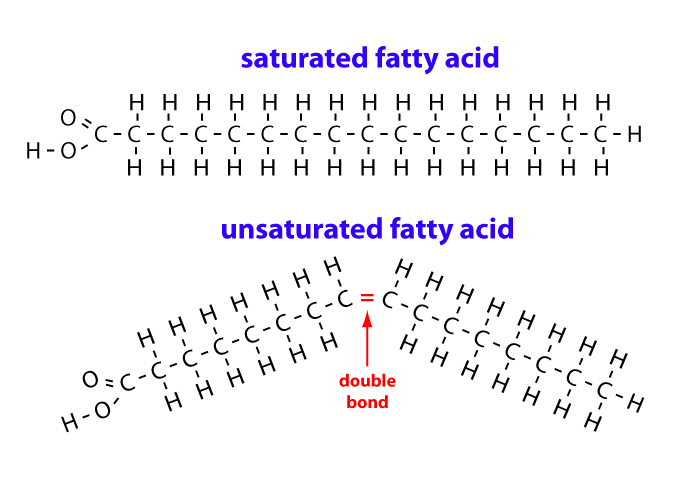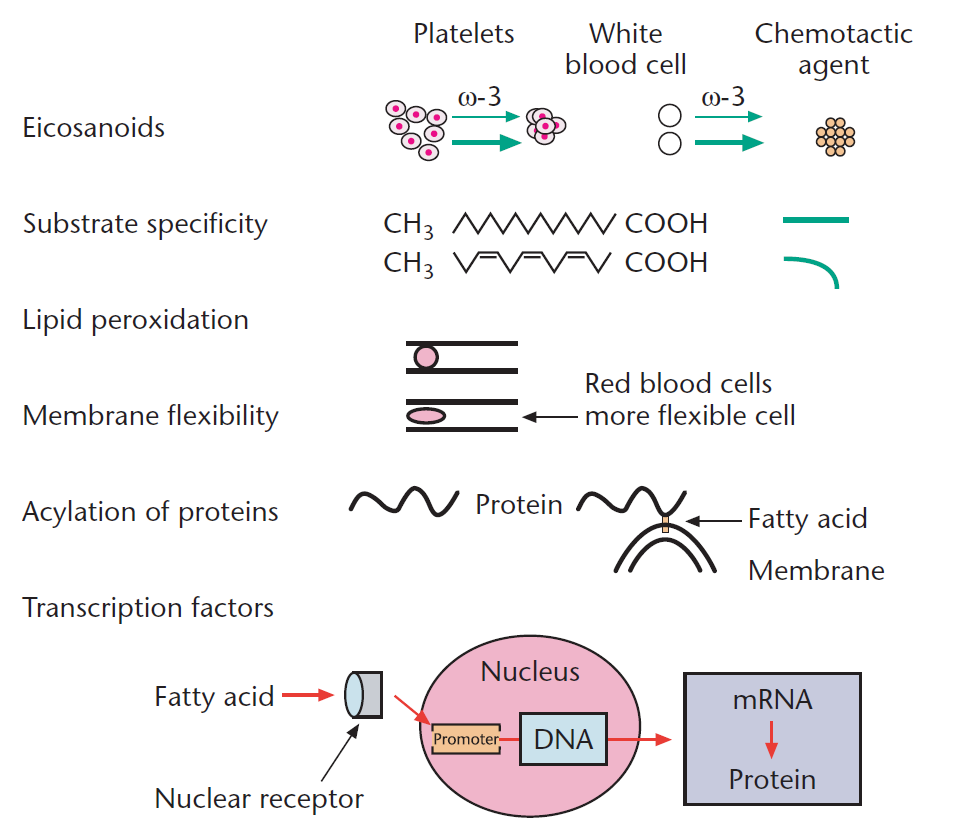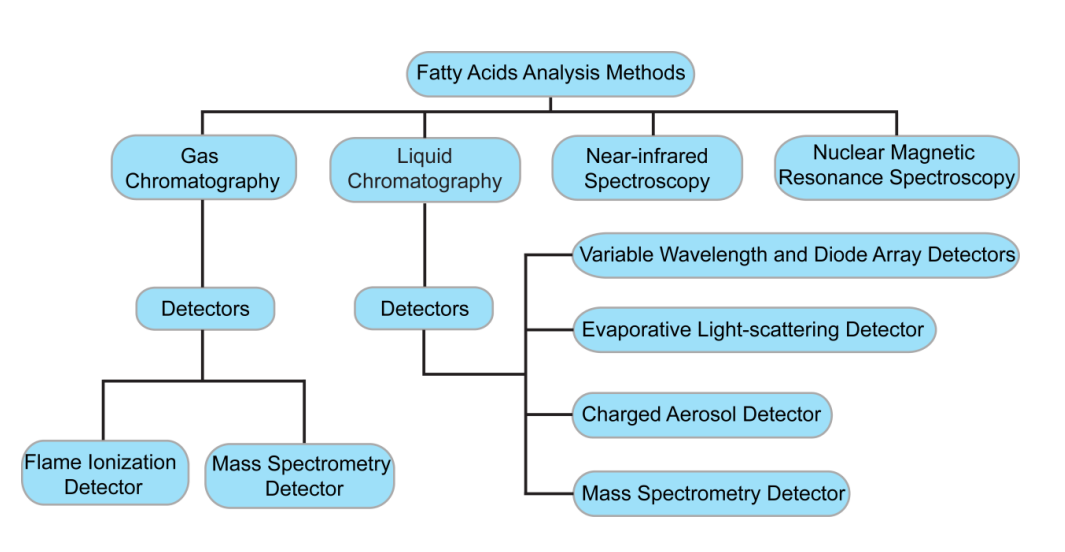Fatty acids (FAs) are hydrocarbon chains of varying lengths and degrees of unsaturation (the presence of double bonds), with a carboxyl group at one end and a methyl group at the other. The most abundant fatty acids have even numbers of carbons, with a straight chain, although exceptions do exist. They are important in human health.
Types of Fatty Acids
According to the length, fatty acids can be classified into short-chain fatty acids (SCFA), medium-chain fatty acids (MCFA), long-chain fatty acids (LCFA), and very long chain fatty acids (VLCFA).
- Short-chain fatty acids (SCFA) refer to fatty acids with two to six carbon atoms, which are mainly produced when dietary fibers are fermented by the bacterial hydrolytic enzymes produced by gut microflora.
- Medium-chain fatty acids (MCFA) are fatty acids with aliphatic tails of 6 to 12 carbons, which can form medium-chain triglycerides (MCT).
- Long-chain fatty acids (LCFA) are fatty acids with aliphatic tails of 13 to 21 carbons.
- Very long chain fatty acids (VLCFAs) are fatty acids with a chain length of 22 or more carbons. Mammals have a variety of VLCFAs differing in chain length and the number of double bonds. Each VLCFA exhibits certain functions.
In addition, according to the number of double bonds, they can also be divided into saturated FAs (SFAs), monounsaturated FAs (MUFAs), and polyunsaturated FAs (PUFAs).
Roles of Fatty Acids
Fatty acids are important components of the human body and they play important roles in cells.
Figure 1. Mechanisms of action for fatty acids (Rustan A C and Drevon C A; 2001)
- The major source of energy. Fatty acids are stored as triacylglycerols (TAGs) in adipose tissue and, to some extent, in skeletal and cardiac muscle. The fatty acids released by TAG hydrolysis are used primarily for the production of energy in the fatty acid β-oxidation pathway in mitochondria and peroxisomes.
- Membrane components. Fatty acids act as main constituents of cellular membranes. The fatty acid composition of the lipid bilayer influences the fluidity of the membrane, which in turn can modify the activities and interactions between integral proteins. When ingesting very long chain ω-3 fatty acids, eicosapentaenoic acid (EPA) and docosahexaenoic acid (DHA) are highly incorporated into membrane phospholipids, which may change the physical characteristics of the membranes.
- Signal Transduction. Fatty acids are involved in a wide range of biological signaling pathways. Fatty acids play important roles in the formation of eicosanoids that are a group of signaling molecules involved in the immune response. The main precursor for eicosanoid synthesis is often arachidonic acid.
- Acylation of Protein. The acylation of proteins plays important roles in anchoring certain proteins in membranes, folding proteins, and the function of multiple proteins. Some proteins are acylated with stearic acids, palmitic acids or myristic acids. Both saturated fatty acids and polyunsaturated fatty acids acylate proteins.
- Gene Expression. Fatty acids or their derivatives (acyl-CoA or eicosanoids) may alter gene transcription by interacting with nuclear receptor proteins that bind to certain regulatory regions of DNA. The combined fatty acid-receptor complex may function as a transcription factor. In addition, fatty acids can modify transcription directly via the family of transcription factors known as peroxisome proliferator-activated receptors (PPARs).
Fatty Acids Analysis
Fatty acids can be found in scarce amounts in free form, but in general, they are combined in more complex molecules through ester or amide bonds. Some methods have been used for fatty acids analysis, including gas chromatography (GC), high-performance liquid chromatography (HPLC), near-infrared spectroscopy (NIRS), and NMR spectroscopy. Each method has its own advantages and limits.
Figure 2. Structural diagram of analytical methods for fatty acids. (Wu Z., et al.; 2017)
GC appears to be the most commonly used method of fatty acids analysis. Fatty acids exhibit low volatility and strong polarity. FAs easily undergo polymerization, deacidification, cracking, and other adverse reactions at high temperatures. As such, FAs are indirectly analyzed by GC. Before GC determination, FAs should be derived to increase their volatility and decrease their polarity. Converting FAs into FA methyl esters (FAMEs) is a classical and commonly used method for deriving fatty acids. GC coupled with a flame ionization detector (FID) is traditionally used to analyze Fas. In addition, GC is frequently combined with MS for highly selective and sensitive quantitative analysis. GC methods with high-quality capillary columns are used for sensitive and reproducible FA analysis. These methods are combined with other techniques for chromatographic separation and spectroscopic identification to characterize complex mixtures of geometric isomers.
At Creative Proteomics, we have developed a professional platform for the identification and quantification of fatty acids by GC-MS. The fatty acids we can provide include:
- Short Chain Fatty Acids Analysis Service
- Medium-chain and Long-chain Fatty Acids Analysis Service
- Very Long Chain Fatty Acids Analysis Service
- Straight Chain Fatty Acids Analysis Service
- Branched Chain Fatty Acids Analysis Service
- Total Fatty Acids Analysis Service
- Free Fatty Acids (FFAs) Analysis Service
References:
- Rustan A C, Drevon C A. Fatty acids: structures and properties. e LS, 2001.
- Burdge G C, Calder P C. Introduction to fatty acids and lipids. Intravenous Lipid Emulsions. Karger Publishers, 2015, 112: 1-16.
- Wu Z, et al. Comparison of critical methods developed for fatty acid analysis: a review. Journal of separation science, 2017, 40(1): 288-298.


